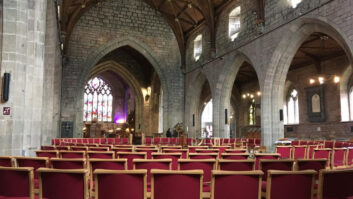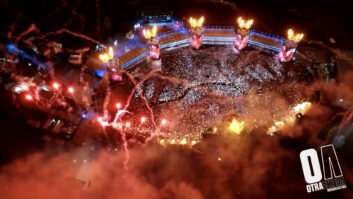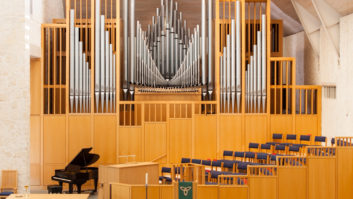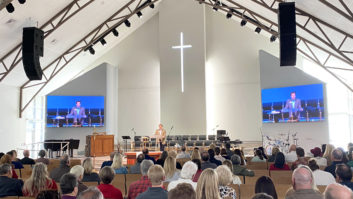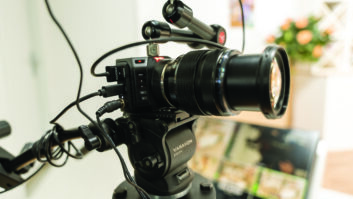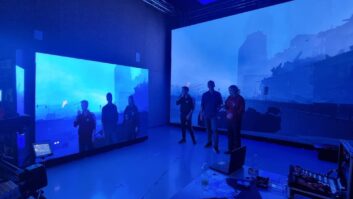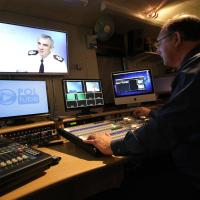
The UK’s Lincolnshire Police has updated its broadcast studio to take advantage of the latest broadcast technology – including Blackmagic Design’s ATEM 2 M/E Production Switcher and 2 M/E Broadcast Panel, so that programme material can be submitted to broadcast media in HD.
The HD studio at Lincolnshire Police uses three digital cameras connected via SDI to Blackmagic’s ATEM 2 M/E Production Switcher; programme output is then sent to a digital hard drive recorder.
If required, additional post production is carried out using Final Cut Pro and then transferred to the web team for distribution to social networking sites, regional media, internal severs or distributed as DVDs in the case of high security.
Value for money
Much of the running cost of the studio is covered by sales of courses and DVD production for other organisations. However, being a publicly funded organisation, Lincolnshire Police had to ensure any investment on their part represented value for money.
“In addition to the ATEM 2 M/E switcher and panel for the studio, we also purchased the ATEM Television Studio for our on the scene training due to its portability,” said Buckley. “Both switchers are feature rich and excellent value for money.”
“The ATEM 2 M/E switcher was perfect for our growing studio and it’s good to know that I have the right tools to cope with more cameras or other gear should we need to expand in the future,” he continued.
For over 40 years, Lincolnshire Police has placed the utmost importance on training, having created a television production unit in the early 1970s. It is used to recreate ‘real life’ scenarios for press officers and training videos for police officers. This includes a small HD studio and an outside broadcast ‘down the line’ environment to put trainees through their paces in a simulated crisis.
Home Office mandate
According to Buckley, an HD television studio was required following a mandate from the Home Office that saw Lincolnshire Police add recording capabilities to its training program.
“With our ability to film and edit training videos on site, it means that we can utilise our distance learning program more by eliminating the need for officers to travel long distances to attend training sessions,” said Buckley.
The training videos are filmed in a mock house setup and actors are hired to act out ‘real life’ scenarios on camera, said Buckley. “Each scene is constructed to demonstrate the appropriate way an officer might handle a variety of scenarios and situations on the job. Implementing a training program in this manner is an important cost saving exercise as we can train a large number of officers with a single video,” he explained.
The television production team also recently wrapped up a campaign on domestic violence. It had two messaging strands; an internal one for police officers to better understand the signs of domestic violence, and a public message encouraging people to report cases of domestic violence.
Public messaging
“Having a television studio at our disposal is vital to our ability to develop public messaging campaigns and training programs,” said Buckley. “We are able to create a lot of content on site, therefore saving on production costs and we get to produce videos which focus on the issues that matter most to our community.”
In addition to training police officers, the television production department also runs national courses for police communicators. The intensive one week courses put new and established communicators through some of the toughest ‘on the job’ situations, including mastering the art of interview techniques and feeding information to spokespeople on camera. Additionally, they are taught how to handle interviews at an incident scene along with how to cope during a media crisis. During this period, Buckley’s production unit creates content in the same way a television broadcaster would.
“Having a real television station environment is vital to training police communicators,” said Buckley. “Working in front of a camera can be overwhelming, and the ability to handle a situation or crisis, in a calm and confident manner is important.”
“They need to understand how to feed information to someone on camera while they are sat in an OB truck away from the scene, or how to keep calm while being grilled on camera by a reporter. While we can’t train individuals for every eventuality, we can at least ensure they have a good understanding of the broadcast environment and what to expect from journalist interview.”
Adding value
Installing affordable broadcast quality equipment has allowed the production department at Lincolnshire Police to add more value, because now the studio can also be used as a working television station that can record and distribute official comment.
“When there aren’t any training courses going on, we will use our studio to bring in senior police officers or spokespeople to deliver a statement on camera in front of a green screen,” continued Buckley. “Having a production switcher with chroma key functionality was important, because it has allowed us to replace the background behind the subject. The footage is then edited, graphic titles are inserted and is available for viewing on the force Intranet the same day.”
“Where necessary we also deliver pre packaged content to broadcasters, and had to have a studio that was HD capable. This included a suitable multi camera setup and having a broadcast quality switcher with professional graphics and chroma key features,” concluded Buckley.
